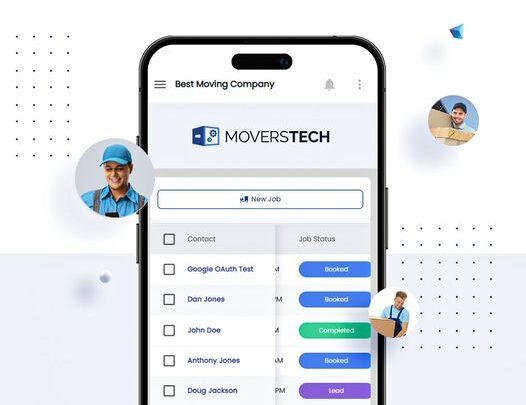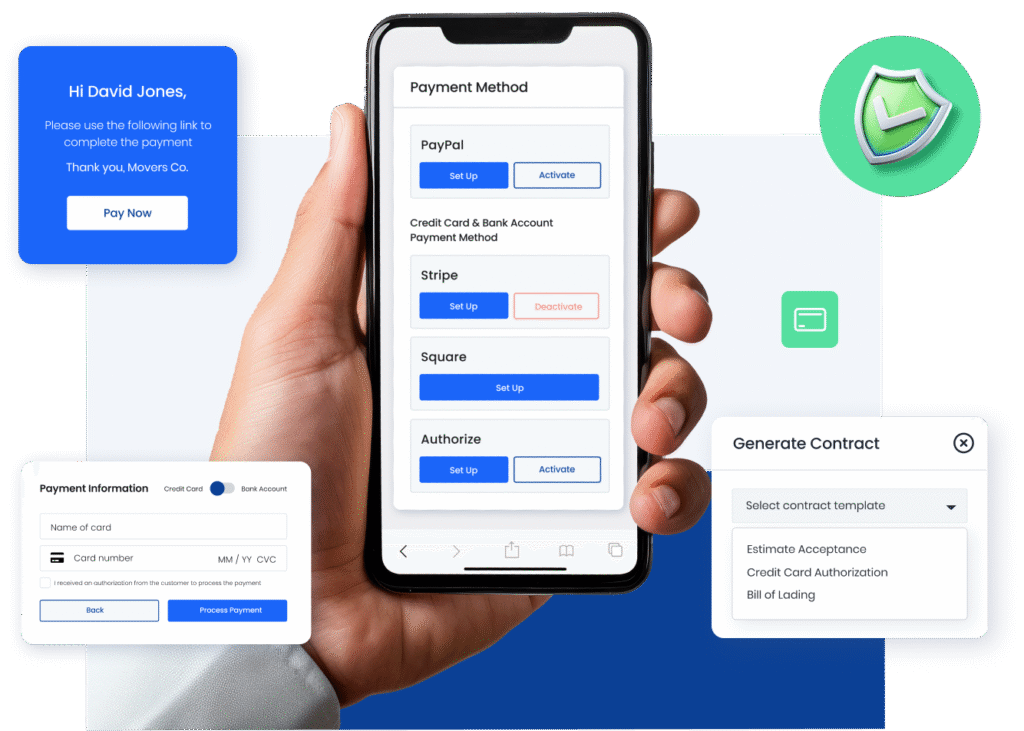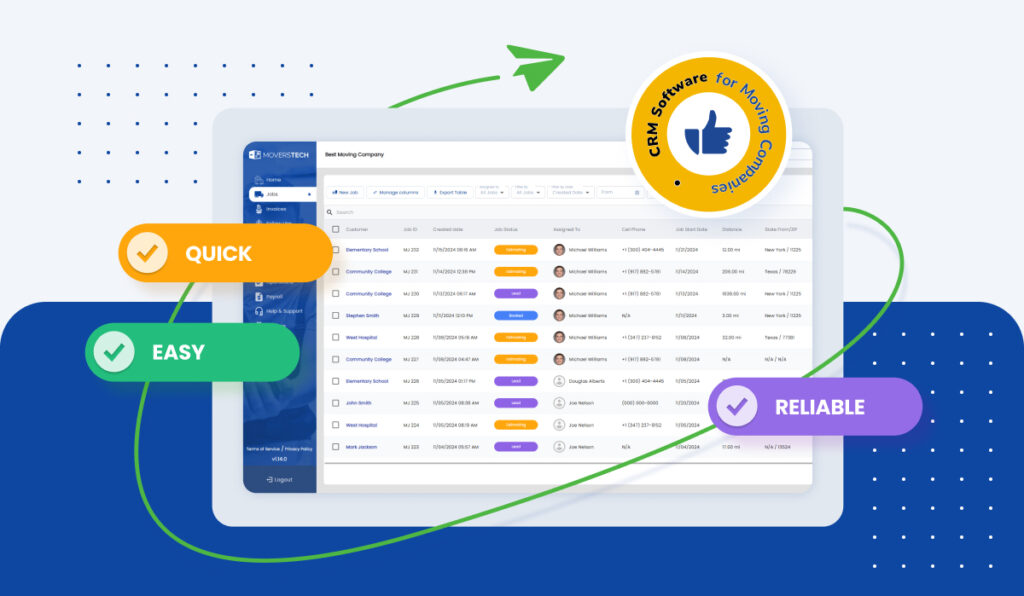Moving industry tech trends worth investing in

Running a moving company today means dealing with constant pressure: higher labor costs, fewer available workers, and customers who expect updates in real time. To stay competitive, movers are turning to smarter tools that cut admin time and improve communication. The latest moving industry tech trends are designed for that reality. They automate scheduling, streamline dispatch, and keep both crews and customers informed without extra calls. Efficiency is now the difference between growth and falling behind. At MoversTech CRM, we help moving businesses adopt the right technology to save time, reduce stress, and stay profitable year-round.
Why staying updated matters
Adopting new technology isn’t just about keeping up appearances. It’s about fixing the problems that slow movers down every day. Many companies still lose hours handling dispatch manually, chasing payments, or following up on leads too late. By following the moving industry tech trends, you will:
- Save time by automating repetitive tasks such as scheduling, invoicing, and follow-ups.
- Improve teamwork with digital tools that keep crews, dispatchers, and customers connected in real time.
- Reduce mistakes through centralized data and automatic updates across departments.
- Speed up operations by eliminating delays caused by manual communication and outdated systems.
- Increase customer satisfaction with faster responses and transparent service updates.
The most important moving industry tech trends
The tools shaping the moving industry in 2025 all solve real, everyday problems. They help movers manage limited staff, speed up communication, and cut time spent on admin work. These are the moving industry tech trends that deliver the biggest impact for growing companies:
- AI and automation
- CRM as the operations hub
- Mobile apps for crews
- Digital payments and paperless documents
- Data and reporting
- Lead generation and marketing tools
AI and automation
One of the most important moving industry tech trends in 2025 is automation powered by AI. Movers face higher costs, staffing shortages, and heavy workloads filled with repetitive tasks. Automation helps by taking over scheduling, dispatching, invoicing, and lead follow-ups. Instead of entering data or coordinating every job manually, AI systems handle these tasks automatically in the background.

Scheduling tools now assign crews based on routes and timing, which saves hours and prevents overlap. Automated dispatch updates job details in real time, so everyone knows where they need to be and when. In sales, AI follow-ups reach new leads instantly after they submit a form, keeping potential customers engaged while reducing the pressure on your team.
Document management is also becoming more advanced. Features like automatic contract creation, e-signatures, and digital storage make paperwork faster and more reliable. Knowing which tools can make this process seamless is key. That is why you should look for the best document automation features
when choosing a CRM.
These systems are not replacements for employees. They support them by handling the routine work that slows them down. When your CRM automates scheduling, billing, and communication, your staff can focus on customer service and on-site performance. For movers working with smaller teams, this means more completed jobs and faster turnaround.
CRM as the operations hub
Among the leading moving industry tech trends, the shift toward all-in-one CRM systems stands out. Movers are replacing multiple disconnected apps with a single platform that manages every part of their business. Instead of using separate tools for leads, dispatch, and payments, a unified CRM keeps everything in one place.
With a system like MoversTech, teams can track inquiries, schedule jobs, assign crews, and handle billing from the same dashboard. This eliminates data loss and miscommunication between teams. Sales teams can see where each lead stands and move them through the pipeline faster. Dispatchers can update job details in real time, and accountants can instantly access invoices and payment records.

A centralized CRM also makes it easier to manage marketing and customer communication. Automated messages, reminders, and updates improve response times without adding more work. The system collects valuable performance data that helps managers identify what needs improvement.
Many movers are also adopting moving leads management software directly inside their CRM. This allows them to store customer data, analyze conversion rates, and focus on high-quality leads.
Mobile apps for crews
Another major moving industry tech trend in 2025 is the use of mobile apps that keep moving crews connected in real time. Many movers still rely on calls and paper job sheets, which slow down communication and cause confusion. Mobile-first tools fix these problems by giving every crew member instant access to job details, schedules, customer notes, and routes directly on their phones.
Crews can now clock in and out, upload photos, log damages, and collect e-signatures on-site. This eliminates delays and ensures the office receives updates instantly. It also cuts down on “where is my truck” calls because customers and staff can both see progress in real time.

These tools go far beyond basic GPS tracking. They act as a live coordination system between drivers, movers, and dispatchers, updating everyone when routes change or new items are added. That level of instant communication keeps operations smooth even when schedules get tight. That is why every moving crew needs a mobile app. For moving companies facing staff shortages or last-minute adjustments, these apps save time, reduce mistakes, and improve service quality.
Digital payments and paperless documents
Digital transactions have become one of the most practical moving industry tech trends in 2025. Movers are moving away from paper contracts, handwritten receipts, and manual billing. Integrated payment systems now allow companies to send digital invoices, collect deposits, and confirm payments instantly. This saves time and eliminates errors that often occur with manual paperwork. Movers using these systems can cut quote-to-payment time dramatically while improving cash flow and customer satisfaction.
Paperless documents also make operations smoother. With e-signatures, customers can sign contracts on their phones or tablets, and copies are automatically stored in the CRM. This process reduces disputes because every signed document is tracked and easy to access when needed.
For movers, digital payment tools mean faster transactions and fewer unpaid jobs. Customers appreciate the simplicity of paying online, while businesses spend less time chasing invoices. Integrated billing and document management also make reporting easier since all financial data stays in one place.
Data and reporting
One of the moving industry tech trends that’s transforming how movers run their businesses is data-driven decision-making. Many companies still rely on assumptions instead of numbers, which makes it hard to identify what’s working and what’s not. Modern CRMs and analytics tools now collect and organize data from every part of the operation.
With detailed dashboards, movers can see which jobs bring the highest profit, which crews perform best, and which marketing channels deliver qualified leads. These insights help managers adjust pricing, improve team efficiency, and focus on the most effective marketing strategies. Accurate reporting also improves accountability. Managers can spot delays, track job completion times, and monitor how quickly leads are converted into booked moves. This information supports better planning and reduces waste.
Instead of running the business on guesswork, movers now have access to clear performance data every day. The result is stronger decision-making and a more predictable workflow. In a competitive industry, understanding your data gives you control over operations and profits. It turns information into action and helps moving companies grow with confidence and precision.
Lead generation and marketing tools
Strong marketing and lead management remain top moving industry tech trends in 2025. Movers no longer rely on buying bulk leads or waiting for calls. With automation and smarter CRM tools, they can attract, track, and convert potential customers more effectively.
Instant quote systems are now integrated with scheduling, inventory, and dispatch. Instead of a simple calculator, these tools provide accurate pricing, real-time availability, and booking options in one place. Adding a moving cost calculator to your CRM helps generate qualified leads while saving office staff hours of manual work.
Automation continues after the quote. With CRM with email automation for movers, every new lead receives a personalized follow-up, reminders, and service updates automatically. This keeps your company in touch without constant manual outreach.
Lead nurturing tools inside CRMs also track which marketing channels deliver the best results. Managers can see which campaigns bring high-value jobs and where to adjust spending. Combined with reporting and analytics, this data helps movers target the right customers at the right time.
Invest in the tech that makes moving easier for everyone
The moving industry tech trends in 2025 focus on solving real business problems such as limited staff, rising costs, and slow communication. These topics, which are the takeaways from Moving Titan Retreat 2025, show how movers are now using automation, analytics, and connected systems to work faster and serve customers better. MoversTech combines these tools in one platform built by movers for movers. It helps companies automate dispatch, manage leads, track performance, and handle payments in one place. With plans starting at $99 per month and more than 300 companies served, MoversTech gives movers practical solutions that work.
Stay Informed
Subscribe for industry
news & updates
"*" indicates required fields
